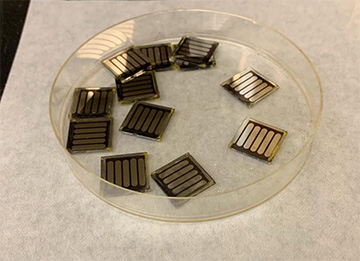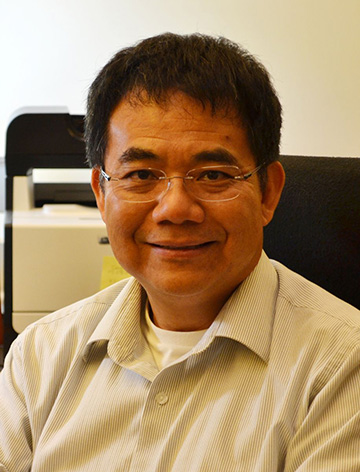
A U.S.–China research team found that adding caffeine to the active layers in lead-halide perovskite solar cells, such as the samples shown here, led to increases in power-conversion efficiency and thermal stability. [Image: Rui Wang and Jingjing Xue]
Materials with a so-called perovskite crystal structure have attracted enduring interest for next-generation photonic and photovoltaic (PV) devices. In particular, perovskite PVs promise both relatively low-cost, low-temperature manufacturing and prospects for lightweight, flexible devices that traditional silicon-based solar cells can’t match.
But while measured power-conversion efficiencies (PCEs) for perovskite PVs in the lab have advanced smartly in recent years, achieving long-term operating stability has been much harder. And that poses a big roadblock for commercial rollout of these next-gen solar cells.
Now, scientists in the U.S. and China offer a novel way to boost both the efficiency and the long-term staying power of certain perovskite PVs: give the cells a jolt of caffeine.
A research team led by Yang Yang at the University of California, Los Angeles (UCLA), found that treating the active layer of a particularly promising variety of perovskite PV, methylammonium lead iodide (MAPbI3), with a small amount of commercially available caffeine could boost the solar cell’s PCE from 17 percent to more than 20 percent—while also extending its thermal stability by hundreds of hours (Joule, doi: 10.1016/j.joule.2019.04.005). While the work is only a proof of concept, Yang says it offers clues toward designing better molecules and mechanisms for moving perovskite PVs closer to commercial viability.
It’s all about the crystals
According to Yang, caffeine gives MAPbI3 perovskites an extra boost by helping to grow better, and better-aligned, crystals in the perovskite film.

Yang Yang. [Image: Courtesy of UCLA]
“A lot of the material’s physical properties are associated with the quality of the crystal, just as with silicon or other materials,” he says. But for perovskites, the rapid rate of crystallization—which, according to Yang, can take place in only a few seconds—tends to work against crystal quality.
The rate and process of crystal growth, he explains, determines the number of defects in the crystal. “And we know from past experience,” Yang says, “that defects are the number-one killer” of the material’s performance.
Clamping on a “molecular lock”
In a strong cup of morning coffee, caffeine works its magic by amping things up. In growing perovskite crystals, its benefits come from slowing things down.
It turns out that when the perovskite-film precursor is treated with caffeine, the caffeine molecule’s two carbonyl groups (double-bonded carbon-oxygen groups that stick off the molecule’s end) latch onto the lead ions in the mix. That “molecular lock,” the researchers say, raises the chemical activation energy, allowing the film to crystallize slower and with substantially fewer defects. As an extra bonus, slowing down the process also nudges the crystals into a favorable orientation for photovoltaic performance, allowing more efficient conversion of solar photons to electrical energy.
In addition to increasing efficiency, caffeine in principle should also help with stability as the perovskite solar cell heats up under operating conditions. In a typical perovskite PV, as the temperature increases, the process that caused it to crystallize tends to run in reverse, introducing crystal defects that degrade both the film and its photovoltaic performance. But the caffeine molecular lock that slows down crystallization should also raise the activation energy for this de-crystallization process, keeping the material crystallographically stable and performing well at high temperatures.
Efficiency and stability gains
To put these ideas to the test, the team fashioned small photovoltaic stacks with MAPbI3 perovskite active layers—both pure, “decaffeinated” layers and layers treated with caffeine at concentrations of up to 2 percent by weight. They found a sweet spot at 1 percent caffeine concentration, where PCE reached a maximum value of 20.25 percent, versus only 17.59 percent for the pure material.
Even more impressive was caffeine’s effect on thermal stability. The team tested both caffeine-treated and pure perovskite devices at 85 °C in a dry-nitrogen environment. The caffeine-treated device held on to more than 86 percent of its original efficiency after 1,300 hours of continuous operation. The device with pure, untreated perovskite, by contrast, had degraded to only 60 percent of its original efficiency after a mere 175 hours. X-ray diffraction analysis after the heat-stress test confirmed that the caffeine-treated samples had retained their crystal structure far better than the untreated samples—evidence of caffeine’s molecular lock in action.

[Image: Getty Images]
Coffee inspiration
Why look at caffeine in the first place? Yang attributes the discovery both to serendipity and to an open culture in the lab, which he says has been working on perovskite technology for more than six years.
The idea first hatched as a sort of joke among graduate students over their morning coffee, with one student wondering aloud what it was about caffeine that made people more energetic—and whether the same mojo might also boost the performance of perovskite PVs. Meanwhile, notes Yang, another student elsewhere in the lab had already been working on perovskite chemistry using a different molecule with a structure similar to that of caffeine. As the students looked at the caffeine structure, he says, “they knew this might be a jackpot. So they worked on that.”
“We do sometimes have good luck,” Yang observes. “But because we have a good culture of open discussion, and students willing to share ideas, it helps to create new ideas.”
Next step: Designing better molecules
While the caffeine experiments establishing the molecular lock mark a step forward, Yang cautions that there’s still “a lot of work to do.” He points out, for example, that the PCE measurements have been made only in small PV cells—not in the large panels of a commercial installation, where increased resistance at electrical contacts would be expected to reduce efficiency. And on the stability side, the team’s experiments measured only thermal stability in dry nitrogen, not stability in a humid environment, which is also important.
Moreover, even the impressive thermal-stability increase reportedly offered by the caffeine treatment appears modest compared with the operating lifetimes of rooftop silicon-based solar panels, which can stretch for 20 years or more. For perovskite, “1,300 hours at 85 °C is very impressive,” says Yang. “But it’s still not enough to put on the roof yet.”
Nonetheless, Yang says the research on caffeine could open up new ways to tweak perovskite chemistry for longer lifetimes and better performance. Going forward, he says, “we want to understand the detailed mechanism, and then ask, Can we design a better molecule?” And the initial work with caffeine, he maintains, has given the team “some confidence about the direction to go in in the future. So I’m very excited about this work.”
In addition to the UCLA-based scientists, the team also included researchers from Soochow University and Jilin University, China, and Solargiga Energy, Hong Kong. The lead authors, Rui Wang and Jingjing Xue, are both Ph.D. candidates in Yang’s lab.
